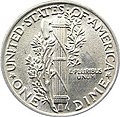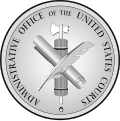Fasces

Fasces (/ˈfæsiːz/, a plurale tantum, from the Latin word fascis, meaning "bundle"[1]) symbolize summary power and jurisdiction, and/or "strength through unity".[2]
The traditional Roman fasces consisted of a bundle of white birch rods, tied together with a red leather ribbon into a cylinder, and often including a bronze axe (or sometimes two) amongst the rods, with the blade(s) on the side, projecting from the bundle.[3] It was used as a symbol of the Roman Republic in many circumstances, including being carried in processions, much the way a flag might be carried today.
Symbolism
Numerous governments and other authorities have used the image of the fasces as a symbol of power since the end of the Roman Empire. It has also been used to hearken back to the Roman republic, particularly by those who see themselves as modern-day successors to the old republic and/or its ideals. Italian fascism, which derives its name from the fasces, arguably used this symbolism the most in the 20th century. The British Union of Fascists also used it in the 1930s. However, unlike (for example) the swastika, the fasces, as a widespread and long-established symbol in the West, have avoided the stigma associated with much of fascist symbolism, and many authorities continue to display them.
Antiquity
The fasces lictoriae ("bundles of the lictors") symbolised power and authority (imperium) in ancient Rome. A corps of apparitores (subordinate officials) called 'lictors' each carried fasces as a sort of staff of office before a magistrate, in a number corresponding to his rank, in public ceremonies and inspections. Bearers of fasces preceded praetors, propraetors, consuls, proconsuls, Masters of the Horse, dictators, and Caesars. During triumphs (public celebrations held in Rome after a military conquest) heroic soldiers—those who had suffered injury in battle—carried fasces in procession.
Roman historians recalled that twelve lictors had ceremoniously accompanied the Etruscan kings of Rome in the distant past, and sought to account for the number and to provide etymologies for the name lictor.
Believed to date from Etruscan times, the symbolism of the fasces at one level suggested strength through unity. The bundle of rods bound together symbolizes the strength which a single rod lacks. The axe symbolized the state's power and authority. The ribbons binding the rods together symbolized the state's obligation to exercise restraint in the exercising of that power. The highest magistrates would have their lictors unbind the fasces they carried as a warning if approaching the limits of restraint.
Fasces-symbolism may derive — via the Etruscans — from the eastern Mediterranean, with the labrys, the Anatolian and Minoan double-headed axe, later incorporated into the praetorial fasces.
Traditionally, fasces carried within the Pomerium—the limits of the sacred inner city of Rome—had their axe blades removed. This signified that under normal political circumstances, the imperium-bearing magistrates did not have the judicial power of life and death; within the city, that power rested with the people through the assemblies. However, during times of emergencies when the Roman Republic declared a dictatorship (dictatura), lictors attending to the dictator kept the axe-blades even inside the Pomerium—a sign that the dictator had the ultimate power in his own hands. But in 48 BC, guards holding bladed fasces guided Vatia Isauricus to the tribunal of Marcus Caelius, and Vatia Isauricus used one to destroy Caelius's magisterial chair(sella curulis).
The fasces in the United States
The following cases all involve the adoption of the fasces as a visual image or icon; no actual physical re-introduction has occurred.
- In the Oval Office, above the door leading to the exterior walkway, and above the corresponding door on the opposite wall, which leads to the President's private office. (Note: the fasces depicted have no axes, possibly because in the Roman Republic, the blade was always removed from the bundle whenever the fasces were carried inside the city, in order to symbolize the rights of citizens against arbitrary state power (see above).)

- The National Guard uses the fasces on the seal of the National Guard Bureau, and it appears in the insignia of Regular Army officers assigned to National Guard liaison and in the insignia and unit symbols of National Guard units themselves. For instance, the regimental crest of the U.S. 71st Infantry Regiment of the New York National Guard consisted of a gold fasces set on a blue background.
- The reverse of the United States "Mercury" dime (minted from 1916 to 1945) bears the design of a fasces and an olive branch.
- Two fasces appear on either side of the flag of the United States in the United States House of Representatives, representing the power of the House and the country.
- The Mace of the United States House of Representatives, designed to resemble fasces, consists of thirteen ebony rods bound together in the same fashion as the fasces, topped by a silver eagle on a globe.
- The official seal of the United States Senate has as one component a pair of crossed fasces.
- Fasces ring the base of the Statue of Freedom atop the United States Capitol building.
- A frieze on the facade of the United States Supreme Court building depicts the figure of a Roman centurion holding a fasces, to represent "order".[4]
- At the Lincoln Memorial, Lincoln's seat of state bears the fasces—without axes—on the fronts of its arms. (Fasces also appear on the pylons flanking the main staircase leading into the memorial.)
- The official seal of the United States Tax Court bears the fasces at its center.
- Four fasces flank the two bronze plaques on either side of the bust of Lincoln memorializing his Gettysburg Address at Gettysburg, Pennsylvania.
- The fasces appears on the state seal of Colorado, USA, beneath the "All-seeing eye" (or Eye of Providence) and above the mountains and mines.
- On the seal of the New York City borough of Brooklyn, a figure carries a fasces; the seal appears on the borough flag. Fasces can also be seen in the stone columns at Grand Army Plaza.
- Used as part of the Knights of Columbus emblem (designed in 1883).
- Many local police departments use the fasces as part of their badges and other symbols. For instance, the top border of the Los Angeles Police Department badge features a fasces. (1940)
- Commercially, a small fasces appeared at the top of one of the insignia of the Hupmobile car.
- A fasces appears on the statue of George Washington, made by Jean-Antoine Houdon which is now in the Virginia State Capital
- VAW-116 have a fasces on their unit insigina
- San Francisco's Coit Tower has two fasces-like insignia (without the axe) carved above its entrance, flanking a Phoenix.
- The seal of the United States Courts Administrative Office
-
US "Mercury" dime reverse.
-
A fasces appears on either side of the American Flag behind the rostrum in the United States House of Representatives.
-
The Mace of the United States House of Representatives, designed to resemble fasces.
-
The seal of the Senate. Note the crossed fasces at the bottom.
-
The Lincoln Memorial with the fronts of the chair's arms shaped to resemble fasces
-
The emblem of the Knights of Columbus
-
Above the door to Chicago's City Hall
The fasces in France

A review of the images (see images below) included in Les Grands Palais de France Fontainebleau [5][6] reveals that French architects used the fasces as a decorative device as early as the reign of Louis XIII (1610-1643) and continued to employ it through the periods of Napoleon I's Empire (1804-1815). The fasces typically appeared in a context reminiscent of the Roman Republic and/or of the Roman Empire, frequently in conjunction with other Roman symbols such as Roman armor and SPQR standards.
The fasces appears on the helmet and the buckle insignia of the French Army's Autonomous Corps of Military Justice, as well as on that service's distinct cap badges for the prosecuting and defending lawyers in a court-martial.
The fasces in Russia
The iron fence around Alexandrovskiy Sad beside the Moscow Kremlin near the memorial to fallen soldiers incorporates fasces symbolism. (Coming from Red Square past the History Museum, turn left.) The fence has the general appearance of cast-iron fences of the Soviet era, so apparently the Communist régime did not interpret it as a fascist political symbol.
Other modern authorities and movements


The following cases all involve the adoption of the fasces as a symbol or icon; no actual physical re-introduction has occurred.
- Napoleon and the French Revolution; this emblem remains on the front cover of French passports and as part of the French coat of arms
- The Spanish gendarmerie Guardia Civil
- In the 1920s, Italian Fascism, adapting aesthetic elements of ancient Rome, attempted to portray itself as a revival of its Roman imperial past by adopting the fasces for its symbol, as an emblem of the increased strength of the individual fascis when bound into the entire bundle.
- Both the Norwegian and Swedish Police Service have double fasces in their logos.
- The Miners Flag (also known as the "Diggers' Banner"), the standard of 19th-century gold-miners in the colony of Victoria, in Australia, included the fasces as a symbol of unity and strength of common purpose. This flag symbolized the movement prior to the rebellion at the Eureka Stockade (1854).
- The coat of arms of Ecuador, which also features on its national flag, has included a fasces since 1822.
- The coat of arms of Cameroon features two fasces which form a diagonal cross.
- The third flag of Gran Colombia, a former nation in South America, depicted a large fasces entwined with several arrows.
- The coat of arms of Norte de Santander, a department of Colombia, and of its capital Cúcuta, both feature a fasces.
- The crest of the fraternity Alpha Phi Delta displays the fasces in its heraldry.
- The symbol of the National Party (Uruguay) (Partido Nacional)
Sources
Tassi Scandone Elena, Verghe, scuri e fasci littori in Etruria - Contributo allo studio degli insignia imperii. Volume n. 36 della Biblioteca di Studi Etruschi dell'Istituto Nazionale di Studi Etruschi ed Italici, Istituti Editoriali e Poligrafici Internazionali, Pisa - Roma, 2001. ISBN 88-8147-263-5. Pp. 272, con VII tavv. f.t.
See also
- fascio (usage 1890s to World War I)
- ferula
- Labrys
- staff of office
- fascine
- francisca
Notes
- ^ Merriam-Webster Online Dictionary: fasces
- ^ Fascio
- ^ LaDestra.Info » Blog Archive » Il fascio littorio ricostruito nella sua storica realtà
- ^ The Supreme Court Historical Society
- ^ Les Grands Palais de France Fontainebleau , I re Série, Styles Louis XV, Louis XVI, Empire, Labrairie Centrale D'Art Et D'Architecture, Ancienne Maison Morel, Ch. Eggimann, Succ, 106, Boulevard Saint Germain, Paris, 1910
- ^ Les Grands Palais de France Fontainebleau , II me Série, Les Appartments D'Anne D'Autriche, De François I er, Et D'Elenonre La Chapelle, Labrairie Centrale D'Art Et D'Architecture, Ancienne Maison Morel, Ch. Eggimann, Succ, 106, Boulevard Saint Germain, Paris, 1912









